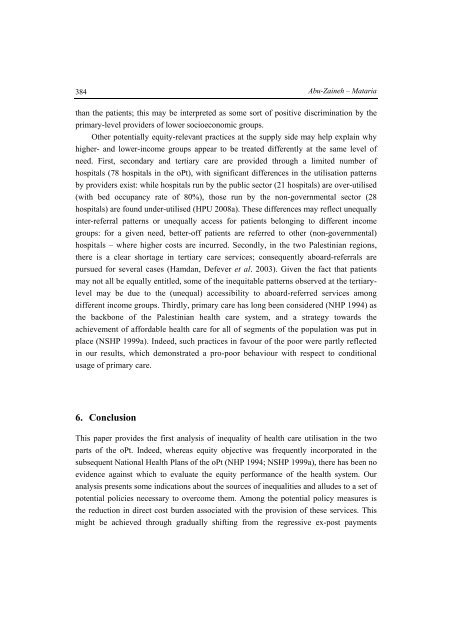The Palestinian Economy. Theoretical and Practical Challenges
The Palestinian Economy. Theoretical and Practical Challenges
The Palestinian Economy. Theoretical and Practical Challenges
You also want an ePaper? Increase the reach of your titles
YUMPU automatically turns print PDFs into web optimized ePapers that Google loves.
384<br />
Abu-Zaineh – Mataria<br />
than the patients; this may be interpreted as some sort of positive discrimination by the<br />
primary-level providers of lower socioeconomic groups.<br />
Other potentially equity-relevant practices at the supply side may help explain why<br />
higher- <strong>and</strong> lower-income groups appear to be treated differently at the same level of<br />
need. First, secondary <strong>and</strong> tertiary care are provided through a limited number of<br />
hospitals (78 hospitals in the oPt), with significant differences in the utilisation patterns<br />
by providers exist: while hospitals run by the public sector (21 hospitals) are over-utilised<br />
(with bed occupancy rate of 80%), those run by the non-governmental sector (28<br />
hospitals) are found under-utilised (HPU 2008a). <strong>The</strong>se differences may reflect unequally<br />
inter-referral patterns or unequally access for patients belonging to different income<br />
groups: for a given need, better-off patients are referred to other (non-governmental)<br />
hospitals – where higher costs are incurred. Secondly, in the two <strong>Palestinian</strong> regions,<br />
there is a clear shortage in tertiary care services; consequently aboard-referrals are<br />
pursued for several cases (Hamdan, Defever et al. 2003). Given the fact that patients<br />
may not all be equally entitled, some of the inequitable patterns observed at the tertiarylevel<br />
may be due to the (unequal) accessibility to aboard-referred services among<br />
different income groups. Thirdly, primary care has long been considered (NHP 1994) as<br />
the backbone of the <strong>Palestinian</strong> health care system, <strong>and</strong> a strategy towards the<br />
achievement of affordable health care for all of segments of the population was put in<br />
place (NSHP 1999a). Indeed, such practices in favour of the poor were partly reflected<br />
in our results, which demonstrated a pro-poor behaviour with respect to conditional<br />
usage of primary care.<br />
6. Conclusion<br />
This paper provides the first analysis of inequality of health care utilisation in the two<br />
parts of the oPt. Indeed, whereas equity objective was frequently incorporated in the<br />
subsequent National Health Plans of the oPt (NHP 1994; NSHP 1999a), there has been no<br />
evidence against which to evaluate the equity performance of the health system. Our<br />
analysis presents some indications about the sources of inequalities <strong>and</strong> alludes to a set of<br />
potential policies necessary to overcome them. Among the potential policy measures is<br />
the reduction in direct cost burden associated with the provision of these services. This<br />
might be achieved through gradually shifting from the regressive ex-post payments
















